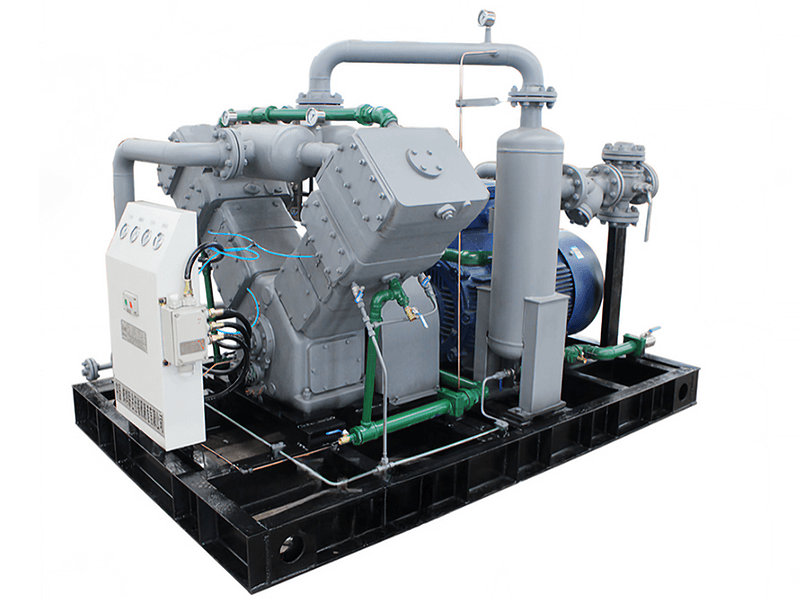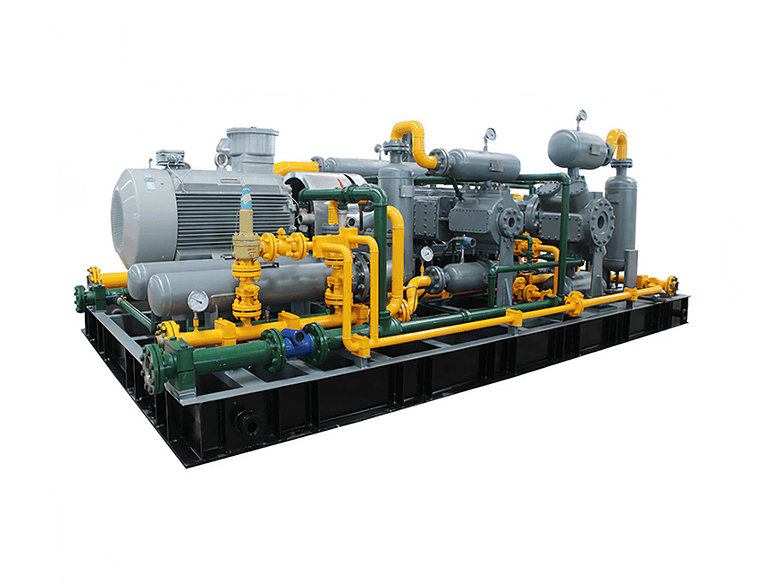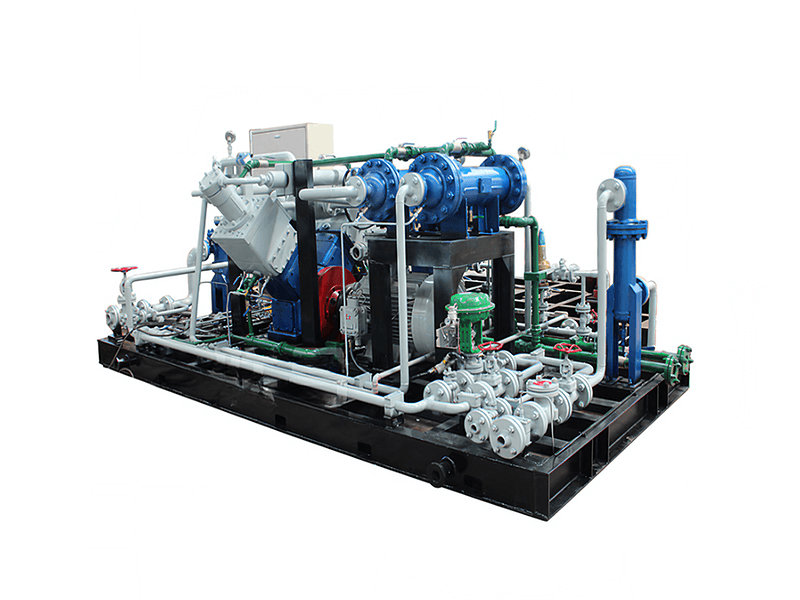Ammonia compressors, like any other mechanical equipment, can experience various faults over time. Here are some common faults that can occur in ammonia compressors:
1. Lubrication Issues:
Low Oil Level: Insufficient lubrication can lead to increased friction, overheating, and premature wear of components.
Oil Contamination: Contaminants in the oil can cause damage to compressor components and reduce efficiency.
2. Liquid Slugging:
Liquid Refrigerant Ingestion: When liquid refrigerant enters the compressor, it can damage the compressor components, leading to mechanical failure.
Impact on Compressor Efficiency: Liquid slugging can reduce the efficiency of the compressor and cause overheating.
3. Overheating:
Causes: Overheating can be caused by factors such as insufficient lubrication, high discharge temperatures, restricted airflow, or improper cooling.
Effects: Overheating can lead to compressor failure, reduced efficiency, and increased energy consumption.
4. Electrical Issues:
Motor Failure: Electrical faults can cause the compressor motor to fail, leading to compressor shutdown.
Overload Tripping: Overloading or electrical issues can cause the compressor to trip, disrupting the system operation.
5. Worn or Faulty Components:
Worn Piston Rings: Worn piston rings can lead to reduced compression efficiency and increased oil carryover.
Faulty Valves: Faulty valves can result in improper compression, reduced capacity, and system inefficiencies.
6. Vibration and Noise:
Causes: Excessive vibration and noise can be caused by misalignment, worn bearings, unbalanced components, or loose mounting bolts.
Effects: Vibration and noise can lead to premature wear of components and reduce the lifespan of the compressor.
7. Refrigerant Leaks:
Causes: Corrosion, wear and tear, or seal failures can lead to refrigerant leaks in the compressor.
Impact: Refrigerant leaks can reduce system efficiency, affect cooling capacity, and pose safety hazards due to ammonia exposure.
8. Compressor Tripping:
Causes: Compressor tripping can be caused by electrical faults, high discharge temperatures, overloading, or refrigerant issues.
Effects: Frequent tripping can disrupt system operation, lead to downtime, and indicate underlying problems.
9. Oil Foaming:
Causes: Oil foaming can occur due to factors such as high oil levels, improper oil viscosity, or contaminants in the oil.
Effects: Foaming can reduce lubrication effectiveness, increase oil carryover, and lead to compressor damage.
10. Suction and Discharge Valve Issues:
Valve Leaks: Leaky suction or discharge valves can reduce compressor efficiency and capacity.
Valve Sticking: Sticking valves can disrupt the compression process and cause irregular operation.
11. Cooling System Problems:
Cooling Water Issues: Inadequate cooling water flow or temperature can lead to overheating of the compressor.
Air-Cooled Compressors: Accumulation of dirt or debris on air-cooled fins can reduce cooling efficiency.
12. Bearing Failures:
Causes: Bearing failures can result from factors like improper lubrication, misalignment, overloading, or wear over time.
Effects: Bearing failures can lead to increased vibration, noise, and eventual breakdown of the compressor.
13. Excessive Wear and Tear:
Causes: Excessive wear can occur due to factors like lack of maintenance, improper operating conditions, or prolonged usage without servicing.
Effects: Wear and tear can reduce compressor efficiency, increase energy consumption, and lead to premature failure.
14. Control System Malfunctions:
Sensor Issues: Faulty sensors or controls can lead to incorrect readings, improper operation, and system malfunctions.
Electrical Control Problems: Wiring issues, control board malfunctions, or programming errors can disrupt compressor operation.
15. Corrosion and Rust:
Causes: Exposure to moisture, chemicals, or corrosive environments can lead to corrosion and rusting of compressor components.
Effects: Corrosion can weaken structural integrity, reduce efficiency, and cause leaks in the compressor.
Addressing these common faults promptly through regular maintenance, monitoring of key parameters, timely repairs, and addressing operational issues can help ensure the reliable and efficient operation of ammonia compressors in industrial applications.

Solutions
Addressing common malfunctions of ammonia compressors promptly is crucial to maintaining the efficiency and reliability of these systems. Here are solutions to some common malfunctions:
1. Lubrication Issues:
Solution: Ensure proper lubrication levels and use high-quality lubricants. Regularly check and change the oil as per manufacturer recommendations.
2. Liquid Slugging:
Solution: Install liquid separators to prevent liquid refrigerant from entering the compressor. Properly size the suction line to prevent liquid carryover.
3. Overheating:
Solution: Check and clean cooling systems regularly. Ensure proper airflow around the compressor. Address any issues causing overheating promptly.
4. Electrical Problems:
Solution: Regularly inspect electrical components for signs of wear or damage. Address wiring issues, overloads, or faulty components immediately.
5. Refrigerant Leaks:
Solution: Conduct regular leak detection tests. Repair leaks promptly and recharge the system with the correct amount of refrigerant.
6. Mechanical Wear:
Solution: Monitor component wear regularly. Replace worn parts before they lead to system failure. Ensure proper alignment of components.
7. Cooling System Failures:
Solution: Inspect cooling systems for clogs, leaks, or malfunctions. Clean or repair cooling components as needed to maintain proper cooling.
8. Control System Malfunctions:
Solution: Check control systems for sensor accuracy and proper calibration. Repair or replace faulty control components to ensure proper operation.
9. Bearing Failures:
Solution: Monitor bearing condition regularly. Replace worn bearings promptly. Ensure proper lubrication to extend bearing life.
10. Excessive Vibration:
Solution: Check for misalignment, loose bolts, or unbalanced components. Address any issues causing excessive vibration to prevent damage.
11. Oil Foaming:
Solution: Use the correct oil type and viscosity. Ensure proper oil levels and address any issues causing foaming to maintain lubrication effectiveness.
12. Valve Issues:
Solution: Inspect valves regularly for leaks or sticking. Repair or replace faulty valves to ensure proper compression and system efficiency.
Proactive maintenance, regular inspections, and addressing issues promptly can help prevent common malfunctions in ammonia compressors. Following manufacturer guidelines, ensuring proper installation, and having trained personnel handle maintenance tasks are essential in maintaining the efficiency and longevity of these critical systems.


























